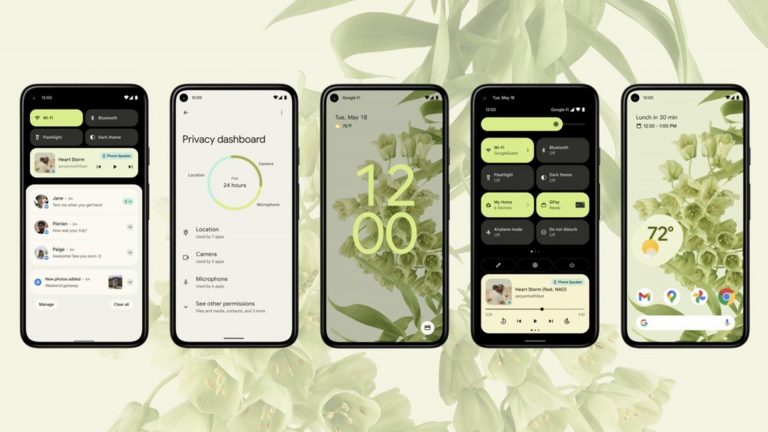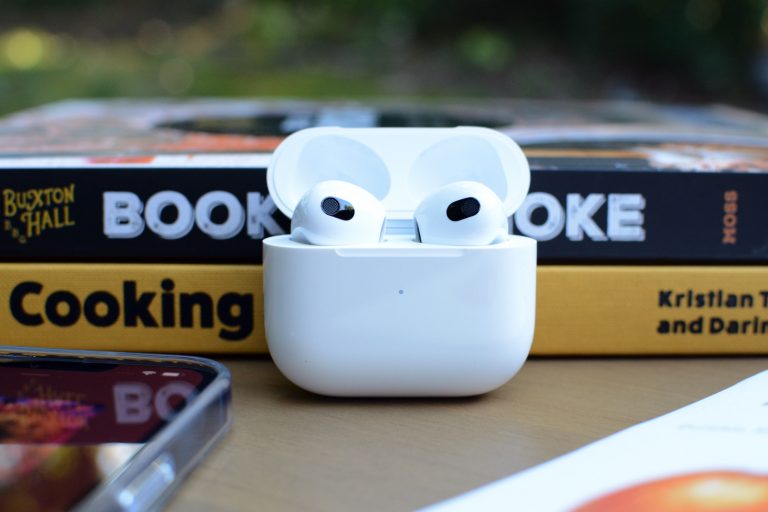Fairphone swings for the fences with its newest smartphone
Ever since its first “ethical” smartphone hit the market, Fairphone reviews have always been haunted by the wary acknowledgement that the devil always has the best toys. But times have changed, and Fairphone can at least be confident that it has won both the moral and the economic argument. Right to Repair laws are currently being kicked around in several US states and Framework is now building Fairphone-esque laptops. If there’s one word I can use to describe the new Fairphone 4, it’s mature. As much as the previous generations of this handset have been good, none deserve as much attention as this one likely does.
First, a caveat: Various global crises have pushed back the launch date for the Fairphone 4. I didn’t receive a unit until a few days before the announcement, so I’ve only had a limited amount of time to give this thing a thorough going over.
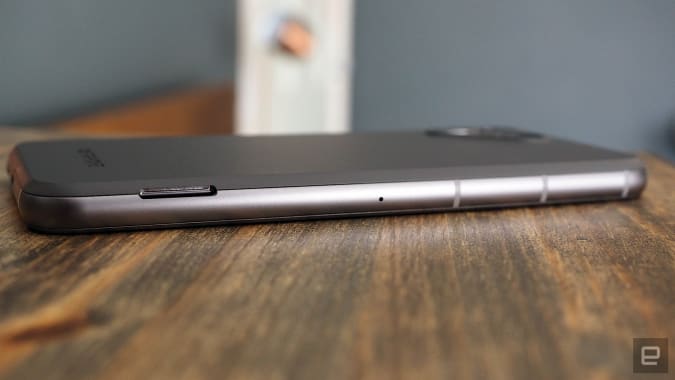
Daniel Cooper
Pick up the Fairphone 4 and you’ll first notice how solid this thing feels in your hand compared to its predecessor. This is not the flimsy plastic concoction we saw in previous generations but a monument, wrought from metal and glass. It may weigh a gram less than the iPhone 11 Pro Max I was holding in my other hand, but this one just feels more substantial. The new metal chassis and thick plastic backplate gives it, to quote Auric Goldfinger, a divine heaviness. I have no qualms about how sturdy and durable this thing is, even knowing that I can pick up replacement parts for very little cash up front.
The design language has changed from the awkwardly long slab of the 3 and 3+ to something that looks a lot more like a current-generation (or at least previous-generation) Android handset. Fairphone has also taken the courageous decision to ditch the 3.5mm headphone jack here in favor of just USB-C. The only things breaking up the outside of the frame, beyond the antenna lines, are a power button with a built-in fingerprint sensor and a pair of sturdy volume buttons. Gone, too, is the conspicuous branding of the previous editions in favor of the company logo edged into the base of the backplate.
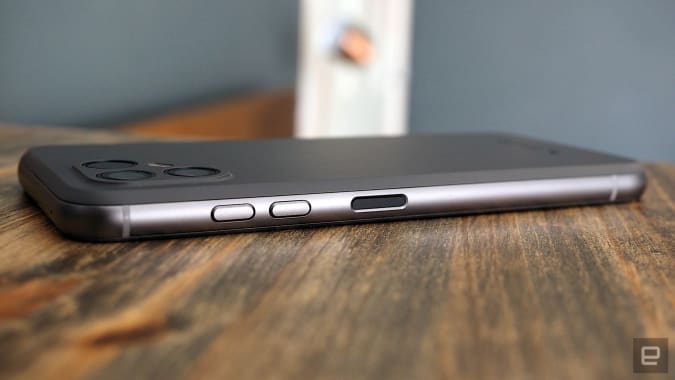
Daniel Cooper
A 6.3-inch Full HD+ display coated with Gorilla Glass 5 takes up most of the room up front, although this is no slim-bezel chin-free edge-to-edge number. The only interruption is the teardrop in the middle of the screen, which houses the 25-megapixel selfie camera. There’s nothing of note to say about the screen, which has a decent backlight, good viewing angles and solid black levels. I think I said a year ago that it’s now hard to mess up a phone display and Fairphone hasn’t fixed what didn’t need mending. Sadly, as good as the vision is, the sound that accompanies it is tinny, thin and reedy with non-existent bass.
Now, Fairphone hasn’t strayed too far from its goal of producing an affordable and reliable modular smartphone. But while it’s splashed out on some specs, others remain firmly in the “nothing to write home about” league. The system-on-chip, for instance, is a Snapdragon 750G, which you’ll find in a number of non-premium 5G handsets like the Moto G 5G and Galaxy A52 5G. It’s worth saying that the 750G offers very respectable performance and tests well in benchmarks but it’s certainly not a screamingly-fast flagship unit.
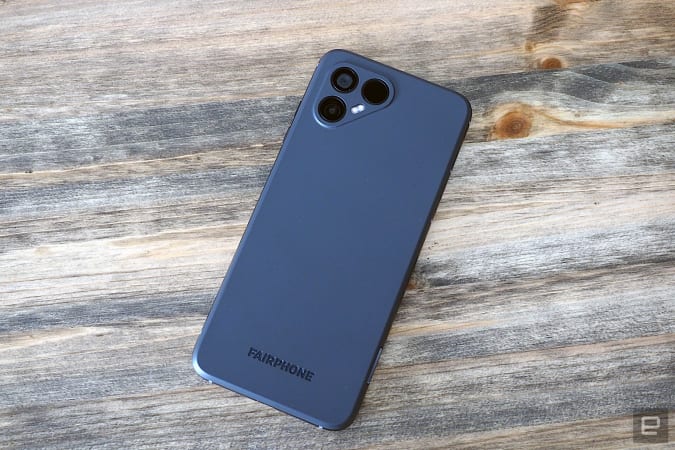
Daniel Cooper
Unlike previous models, Fairphone is actually offering two versions of the Fairphone 4, one with 6GB RAM and 128GB storage, the other with 8GB RAM and 256GB storage. Both can be bolstered with the internal microSD slot that’ll take up to 2TB cards. The Fairphone 4 can support both a physical nano-SIM as well as an eSIM, both of which support 5G (although not simultaneously.)
Fairphone opted for a double-camera setup here with an f/1.6 48-megapixel primary camera packing Sony’s half-inch Exmor IMX582 sensor with OIS. You’ll get 8x digital zoom, and can shoot 4K video at 30fps, or HD slow-motion at 240fps. The second camera is a 48-megapixel f/2.2 120-degree wide-angle lens for landscape photography. Joining those two on the back of the phone is a time-of-flight sensor for better autofocus, which also makes it look like you’re rocking a triple-camera phone.
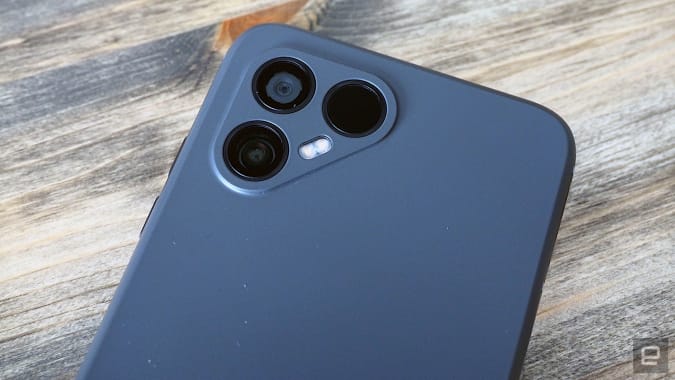
Daniel Cooper
Nestled up front in the teardrop is a 25-megapixel, f/2.2 forward-facing camera which uses a Sony IMX576 sensor. You’ll get support for HDR, 8x digital zoom and the ability to record video in HD at up to 30 fps. The images you get out of that selfie lens are respectable, although even when you shoot 25-megapixel images, you’ll get very little detail when you zoom in and things get muddy pretty quickly.
The company said that I shouldn’t do too many photography tests with the Fairphone 4 until a yet-to-be-distributed software update pushes the final tweaks. That said, the standard camera is perfectly reasonable and the live filters produce pretty lovely images.
Repairing this phone should, again, be relatively easy given how little a challenge it was to upgrade the previous model. Simply pop off the back cover and extract that replaceable 3,905mAh battery and a Phillips 00 screwdriver is all you need to get working. Again, I’ve not had any time to delve yet, but even a quick poke inside makes me think that it’s not more difficult to do any repair job than it was on the older models. One thing to bear in mind, however, is that Fairphone is no longer shipping a screwdriver in the box, assuming instead that you already own a tool suitable for the job.
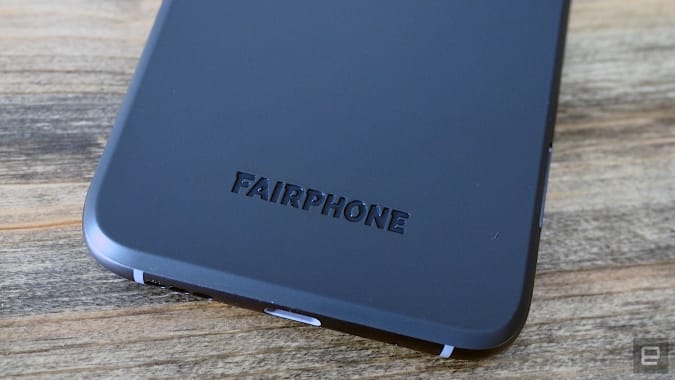
Daniel Cooper
Fairphone has said that it has learned a number of valuable lessons from the launches of its last few handsets. That’s why this new model has a five-year warranty and guarantees software support until 2025 at the earliest, but pledges to keep that going to 2027 at best. (Fairphone has previous here: Earlier this year it managed to get Android 9 running on the Fairphone 2, five years after it was first released.) It also has pledged to ensure that spare parts for the phone remain available until that same 2027 deadline.
Whereas before Fairphone talked about a “fair” supply chain both looking for ethically-clean raw materials and paying workers a fair wage, it also describes the 4 as “e-waste neutral.” This is a neat way of summing up the idea that the company will recycle one device for every Fairphone 4 it sells. In addition, Fairphone can boast that it now uses 70 percent “fair” material inside the handset, including FairTrade Gold and Silver, aluminum from ASI-certified vendors and a backplate made from 100 percent post-consumer recycled polycarbonate.
And while some of the spare parts are a little more expensive than on the previous edition, the prices are more or less affordable. The company supplied me with a parts and price list (in GBP, at least) and the most expensive components are a replacement display and rear camera, which both retail for £69.95 (around $78 before sales tax). The forward-facing camera and battery pack replacements, meanwhile, are £25.95 (around $29), while components like the loudspeaker, USB-C port, earpiece and so on all cost less than £20 (around $22).
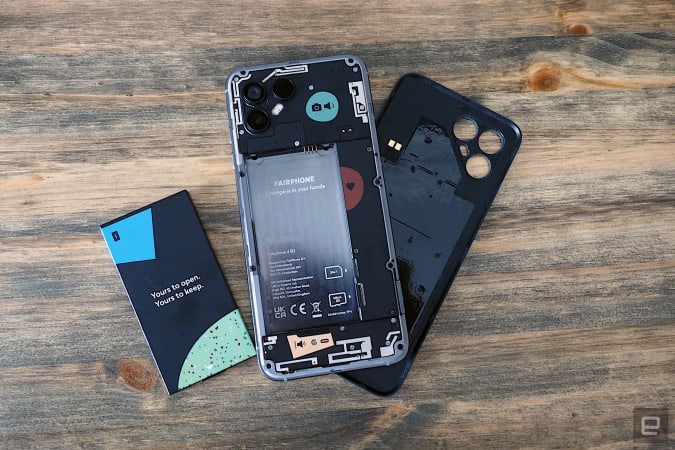
Daniel Cooper
Interestingly, as part of this launch, Fairphone is also launching a pair of true wireless headphones. These are, naturally, one of the most notoriously hard-to-repair and recycle devices currently littering the market. At this point, Fairphone hasn’t tried to re-design these things to be more repairable, but did say that the units were made with “fair and recycled materials” including at least 30 percent recycled plastic and FairTrade Gold.
The Fairphone 4 will be available to pre-order on September 30th, with the first handsets due to arrive on October 25th. Unlike previous years, however, there will be the two previously-outlined variants depending on storage and RAM options. The 6GB RAM / 128GB model will retail for €579 / £499, while the 8GB / 256GB model will set you back €649 / £569.
All products recommended by Engadget are selected by our editorial team, independent of our parent company. Some of our stories include affiliate links. If you buy something through one of these links, we may earn an affiliate commission.


